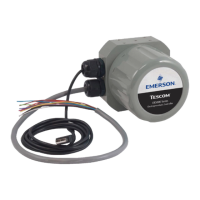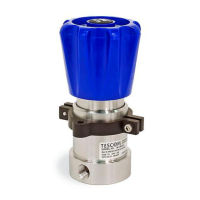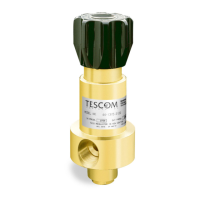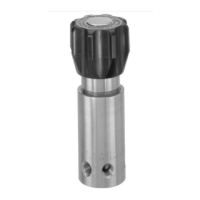ER5000 —
6
Safety, Installation & Operations Precautions
TESCOM™ REGULATORS
WARNING
DO NOT ATTEMPT TO SELECT, INSTALL, USE OR MAINTAIN THIS
REGULATOR, VALVE OR ACCESSORY UNTIL YOU HAVE READ AND FULLY
UNDERSTAND THESE INSTRUCTIONS.
BE SURE THIS INFORMATION REACHES THE OPERATOR AND STAYS WITH THE
PRODUCT AFTER INSTALLATION.
DO NOT PERMIT UNTRAINED PERSONS TO INSTALL, USE OR MAINTAIN THIS
REGULATOR, VALVE OR ACCESSORY.
IMPROPER SELECTION, IMPROPER INSTALLATION, IMPROPER MAINTENANCE,
MISUSE OR ABUSE OF REGULATORS, VALVES OR RELATED ACCESSORIES CAN CAUSE
DEATH, SERIOUS INJURY AND/OR PROPERTY DAMAGE.
OXYGEN SERVICE REQUIRES SPECIAL EXPERTISE AND KNOWLEDGE OF SYSTEM
DESIGN AND MATERIAL COMPATIBILITY IN ORDER TO MINIMIZE THE POTENTIAL
FOR DEATH, SERIOUS INJURY AND/OR PROPERTY DAMAGE.
Possible consequences include but are not limited to:
• High velocity uid (gas or liquid) discharge
• Parts ejected at high speed
• Contact with uids that may be hot, cold, toxic or otherwise injurious
• Explosion or burning of the uid
• Lines/hoses whipping dangerously
• Damage or destruction to other components or equipment in the system.
CAUTION
SAFETY PRECAUTIONS
1. Inspect the regulator, valve and accessories before each use.
2. Never connect regulators, valves or accessories to a supply source having a
pressure greater than the maximum rated pressure of the regulator, valve
or accessory.
3. Refer to product label (model specic) for maximum inlet pressures. If this
rated pressure cannot be found, contact your local TESCOM representative for
the rated pressure prior to installation and use. Verify the designed pressure
rating of all equipment (e.g., supply lines, ttings, connections, lters, valves,
gauges, etc.) in your system. All must be capable of handling the supply and
operating pressure.
4. Clearly establish ow direction of the uid before installation of regulators,
valves and accessories. It is the responsibility of the user to install the
equipment in the correct direction.
5. Remove pressure from the system before tightening ttings, gauges
or components.
6. Never turn regulator or valve body. Instead hold regulator or valve body and
turn tting nut.
7. If a regulator or valve leaks or malfunctions, take it out of service immediately.
8. Do not modify equipment or add attachments not approved by
the manufacturer.
9. Apply pressure to the system gradually, avoiding a sudden surge of uid or
pressure shock to the equipment in the system.

